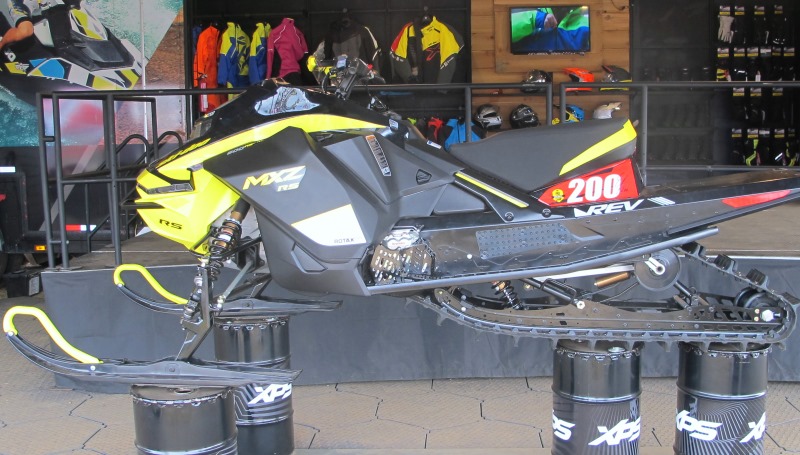A couple of days after announcing it had stolen one of its competition’s top racers, Ski-Doo followed up by unveiling a 2020 race sled that should help the brand that dominated the starting line in snocross last year get to the first corner even more quickly.

With pledges on building on the dominating performance its racers had on snocross courses on the Amsoil Championship Series and other circuits last season, Ski-Doo unveiled its 2020 MXZx 600RS E-TEC snowmobile at a crowded Haydays event on September 7.
To the passive observer, the specialty race machine may not have looked much different than last year’s model – though some may notice a slightly different angle to the tunnel and a repositioned taillight. However, multiple changes found throughout the machine are aimed at giving Ski-Doo snocross teams improved holeshots off of the starting line, a bit more horsepower, improved durability and more control over the suspension systems.
“We had an incredible season last year – a lot of wins, a lot of podiums, a lot of championships,” Ski-Doo Race Coordinator Carey Daku said before namechecking the crew in Quebec that designed the 2019 sled and then updated it for 2020. “They weren’t complacent – for this year’s sled, we made a lot of refinements. It’s already on a great platform, so we’re excited for next season, and ready to have another dominating season like we just had last season.”

Starting up front, most visual on the front suspension is the fact that the high-end KYB shock shocks are reverse-mounted so their piggyback remote reservoirs are pointed inward, toward the bulkhead. That makes the clickers hard to reach, but protects the reservoirs from damage that occurs when a pack of amped up snocross racers pour into the first turn and trade paint.
More notable, though, is that those shocks have new integral base valves that allow more exterior adjustment of the shocks. Specifically, the new Kashima coated KYB Pro Series shocks found above the skis and also on the skid’s rear arm have separate high- and low-speed rebound clickers – that’s right, not just high- and low-speed on the compression side, but also on the rebound side. Admittedly, Ski-Doo’s top racers have been using shocks with that adjustability in recent years but now they come as standard equipment, meaning even the kids in Juniors and Sport classes get the added adjustability.

The Racing rMotion rear suspension also gets a new mechanical holeshot device that locks the rear scissor until the rider hit the first bump, which the releases it. It allows for quicker response off a starting line and has been used by other brands. The skid also gets more durable suspension rails.
Meanwhile, a revised 600RS E-TEC engine featuring new cylinders in the mono block design, with plasma coating and revised porting that is said to produce more horsepower once the engine revs above 6000 rpm. There are also engine calibration updates, Daku said.
For reduced chassis flex, a new larger backing plate is used on the Brembo brake, plus the rails were beefed up on the Racing rMotion skid for improved durability. Meanwhile, Ski-Doo also redesigned the tunnel, starting its upward tilt underneath the seat to give more clearance for the track. Also, the cooling system was updated, with a shorter heat exchanger system that loops underneath the tunnel, taking away the plumbing previously found behind the seat. The LED taillight was also moved forward onto the back of the seat.
Also notable, the hood is said to be more durable thanks to new Lexan material, and a new fuel pump is found inside the gas tank that will allow Ski-Doo racers to keep the sled running on less fuel than in the past – or, they’ll be able to carry less fuel during a race, and knowing that gas weighs 6.1 pounds a gallon, that can be important.
Editor’s Note: Every Snow Goer issue includes in-depth sled reports and comparisons, aftermarket gear and accessories reviews, riding destination articles, do-it-yourself repair information, snowmobile technology and more. Subscribe to Snow Goer now to receive print and/or digital issues.





